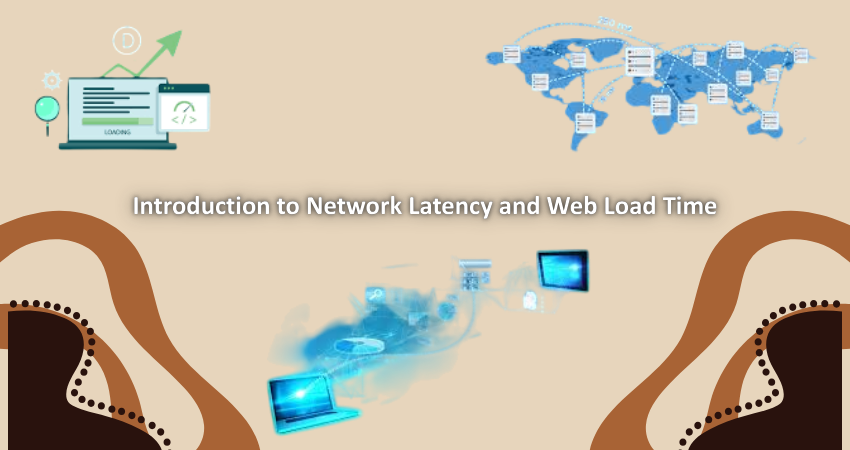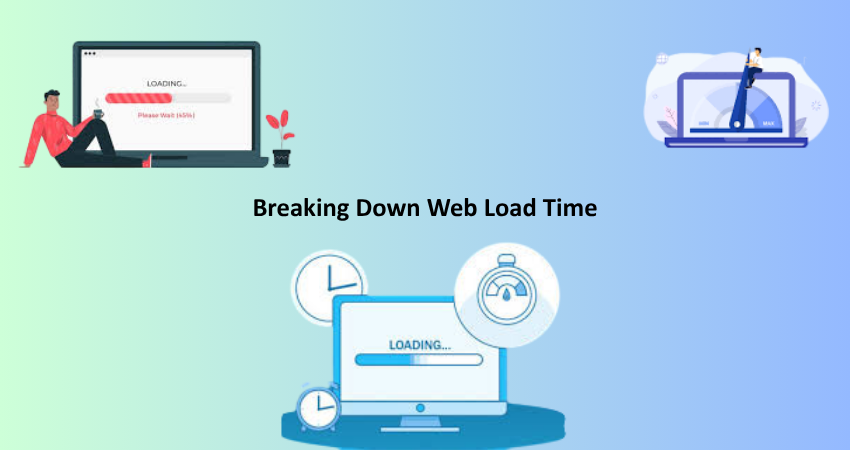
Introduction
In the new speed-driven world of the web, the trend nowadays is that users want to access content quickly without any hassles. Failing to meet this would be detrimental to businesses in terms of conversion, retention as well as search. Web performance could be attributed to a lot, but among the most essential and somewhat common but little-understood measures would probably be network latency and web load time. These terms are confused with each other, but they mean different things when it comes to site-hitting speed.
Network latency is the time elapsed between the customer’s action (like a clicking link) and the reception of that first bit of response from the server. On the other side, web load time could also mean the time elapsed while waiting for a page to finish loading and even be interactive in the browser. Hence, knowing the meaning of latency and load time cements their role in web performance optimization by enabling better user experience. In this article, we will elaborate on both terms, what can affect them, and the steps that could be taken to minimize their impact.
Understanding Network Latency
What Is Network Latency and Why Does It Matter?
Network latency refers to the time that elapses when data is passed back and forth from a client (for example, a browser) to a server. The term is calculated in milliseconds (ms), and it is simply the delay relative to how quickly a request can travel online and return its response. Data travels at the speed of light, but delays can mount considerably, depending on the geographic distance between the user and the server or the number of intermediaries—the routers and firewalls or the ISPs—that lies in between. For an instance, if someone in Tokyo somehow accesses an online server in New York, latency is going to be vastly more on that case than if one was using a server local to the location.
Latency is thus critical to web performance, as it often takes multiple round trips between a browser and a server to complete the entire web page action, such as loading HTML, CSS, images, or JavaScript. The result is that the longer each such trip costs in latency, the slower the experience for the user. This becomes even more pronounced when dealing with a dynamic website—most of the page requests to the server might occur while the user is performing an operation on the website. Although just a little detail in the technical sense, latency tends to cause a great difference: a site that is sluggish due to high latencies can be irritating, and it could lead to more exit rates and finally hit the bottom line of the business.
Factors That Contribute to Network Latency
Latency is affected by many factors, and recognizing these factors is essential in reducing latency. The. First and fore-most is physical distance. The greater the distance that data has to travel, the longer it takes. Wherever the server has the highest performance potential, if it is positioned away from the users, latency increases. This is one of the reasons why CDNs are used-to serve data from an area closer to the user. Other most important factors include network congestion, which actually refers to packets of data competing for limited bandwidth along the same path causing delays or retransmission.
The complexity of routing-the number of hops between client and server-added milliseconds in the process. Each router or intermediary device delays the actions while processing data. Firewalls, NAT gateways, load balancers, and the like can also add their own latency. Additionally, DNS resolution time-timing the translation of a domain to an IP address-can potentially create the first delay, not at the client’s request. More importantly, there is protocol overhead such as HTTP/1.1 making new connections for every request, which increases latency. The latency could be alleviated substantially by switching over to newer protocols such as HTTP/2 or HTTP/3, which allow multiplexing and connection reuse.
Breaking Down Web Load Time

What Is Web Load Time and How Is It Measured?
The time taken for a web page to become fully functional within a browser constitutes web load time. From the time the user initiates a request until the page becomes active; it encompasses not only the display of the page on the screen, but also when users may scroll, click buttons, or enter text. Load Time is assessed through various performance indicators such as Time to First Byte (TTFB), First Contentful Paint (FCP), Largest Contentful Paint (LCP), and Time to Interactive (TTI). Each metric provides insight into a different aspect of the loading process.
Time taken for loading is significant as it relates directly to user satisfaction and interaction. Even a few seconds of a delay can convert conversions or page views by a significant margin. As per research, more than 53% of mobile users abandon a site when the loading time exceeds 3 seconds. That is why web load time is always a vital factor in Google’s Core Web Vitals and their SEO ranking. Everything from compressing assets and using efficient code to optimizing images and minimizing render-blocking resources is involved in the optimization of time. Unlike latency, which is mostly related to the network issue, load time is massively dependent on the way one builds and delivers the web pages.
The Lifecycle of a Web Page Load
Considering it takes a couple of phases in loading a page to grasp how web load time works, the cycle starts with DNS lookup, then establishing connection to the server using TCP (or QUIC for HTTP3), and the actual request initiation where the browser makes an HTTP request and waits for a response. This includes Time to First Byte, which measures how fast the server responds with data. Thereafter begins rendering- whereby the browser receives the HTML, parses it, and starts loading external resources like styles, scripts, and images.
In this age, every modern web page is a complex conglomeration of scripts and third-party services- all interfering with rendering or postponing interactivity. Rendering starts on those larger visual elements once the browser paints the first pixels of content (as measured by FCP), then that page reaches medium visual interactivity (LCP), and finally becomes interactive (TTI). Malicious scripts, heavy images, or too many fonts may unreasonably delay these activities. Conversely, making scripts asynchronous or using client-side rendering approaches such as React or Angular might postpone anything meaningful from showing up on the screen. This is why optimizing for speed needs to take the whole [timed] lifecycle into account-from server response times to delivery of front-end assets.
The Relationship Between Latency and Load Time
How Latency Impacts Load Time in Real Scenarios
Latency and load time might comprise separate entities, but they bear such a close relationship that one principally affects the other. Essentially, any HTTP request initiated during the loading of a webpage acts to impede by some considerable degree the prevailing network latency. Consider a page loading 50 resources (such as images, CSS files, and scripts), each of which requires an individual HTTP connection; in such a case, latency can rapidly amass. Hence, 100ms of latency per HTTP request can very well extend to several seconds. Therefore, it serves as a key performance objective to reduce such round trips. Bundling files, utilizing CDNs, and multiplexing over HTTP/2 are some of the techniques that can help reduce the effect of latency.
With an even slight rise in latency, interactivity is slowed down or a bad user experience is established, especially when looked at using a mobile device or low-bandwidth connection. Interactivity may well be stalled by high latency, which is an important user experience determinant, even when the lightweight page is provided. Another great contributor to latency bottlenecks includes third-party APIs, fonts, or tracking scripts that are loaded from remote servers. Hence, as a developer, one must always analyze how lag-sensitive each aspect of their site is. For instance, a hero image or your main headline should never be delayed by resources that are being fetched from too far away. Latencies play a big role in appraisal against a geographically distributed audience, thus making global optimization strategies such as edge caching a necessity.
Strategies to Mitigate Latency’s Effects on Load Time
Bringing latency to bear in web load time is first made possible through the use of a CDN. CDNs replicate content on servers worldwide and serve it from the closest geographical node to a user, significantly reducing round-trip time. The Cloudflare partner, Akamai, or AWS CloudFront is among the leading ones in this aspect. Another very potent one is the compression of assets, not limited to CSS, JS images, or some other form. With Gzip or Brotli, payloads may be quite smaller, allowing each request to be faster despite high-latency networks.
Use connection reuses and persistent connections to reduce latencies. HTTP/2 and HTTP/3 permit multiple requests to be sent over an open connection-the only cost is the overhead of establishing a connection for the whole site at least once, rather than for every single file. Devs can preload or preconnect key assets to save DNS and connection time. Finally, by limiting the number of external scripts and features-asynchronous loading for things that do not affect main content (like chat widgets or analytic trackers)-latency induced by third-party services cannot prevent rendering of primary content. This is probably the best argument for using a combination of front-end optimization and network strategies to minimize latency drag on web load time.
Tools and Best Practices for Measuring and Improving Performance

Key Tools to Measure Latency and Load Time
In evaluating a system to improve on its latency and load time, the first thing to do is to measure just that. Fortunately, there are many tools that give in-depth information. Google PageSpeed Insights and Lighthouse are just a couple of very popular tools for measuring performance and give insights into LCP, TTI, and CLS (Cumulative Layout Shift), along with actionable advice. The best part is they are freely available, easy to operate, and provide lab and field data, hence being most suitable to developers and SEO professionals. Much more granular visibility is available with WebPageTest, which enables simulating different connection speeds, browsers, and geo-locations to test out how these change latency and, hence, load time.
On the other hand, New Relic, Pingdom, and GTmetrix can monitor in real-time performance metrics. Additionally, Chrome DevTools allows developers to inspect waterfall charts in-browser to see which resources take the longest to load. If globe-trotting performance is your focus, Cloudflare Analytics or Catchpoint would give enterprise-grade insights that detail how latency varies by region. Measuring is half the battle—once you know what’s slowing your site down, you can prioritize the optimizations and easily measure the impact of your improvements.
Best Practices for Optimizing Network and Site Speed
Once you load your data, you have to improve performance in every part of the stack. For the front-end aspect, minify HTML, CSS, and JavaScript, and clean up everything about render-blocking resources using async and defer attributes. Use lazy loading for images and videos so they do not block the initial paint. Next comes browser and server caching. Proper cache headers prevent unnecessary requests and dramatically improve repeat load speeds.
From the network point of view, enable DNS pre-fetch, preconnect, and prefetch for the most critical third-party assets. Use modern protocol to reduce latency and packet loss, such as HTTP/3. On the backend, ensure you optimize your server performance with cache applications such as Redis, enable object compression, and monitor TTFB from time to time. Security tools like firewalls or anti-bot services should also be configured carefully to avoid unnecessary delays. Regular audits and performance reviews are carried out, particularly after new features have been deployed. Performance is not a one-time task; it’s an ongoing discipline that rewards every incremental gain.
Conclusion
No doubt, latency and load-time on the web are two of the most important and often neglected indicators of web performance. Latency Load-time is the aspect that users get to see and feel, while latency is the invisible hand affecting every digital experience. Both factors will exert a sizable influence on bounce rates, search engine optimization (SEO) rankings, and user engagement, which will either go in favor of or against business success.
These are the underlying concepts that, if explored, can give developers those much-needed gains in that arena by establishing causes of delays and applying suitable proven optimization methods. Be it a CDN, HTTP/3 adoption, or rendering path optimization—all these optimizations yield incremental gains. In an age where milliseconds count, managing latency and load time not only becomes a technical challenge but rather a competitive edge. So start small, measure every little thing, and iterate again and again. What you’ll end up with is a fast yet delightful website.